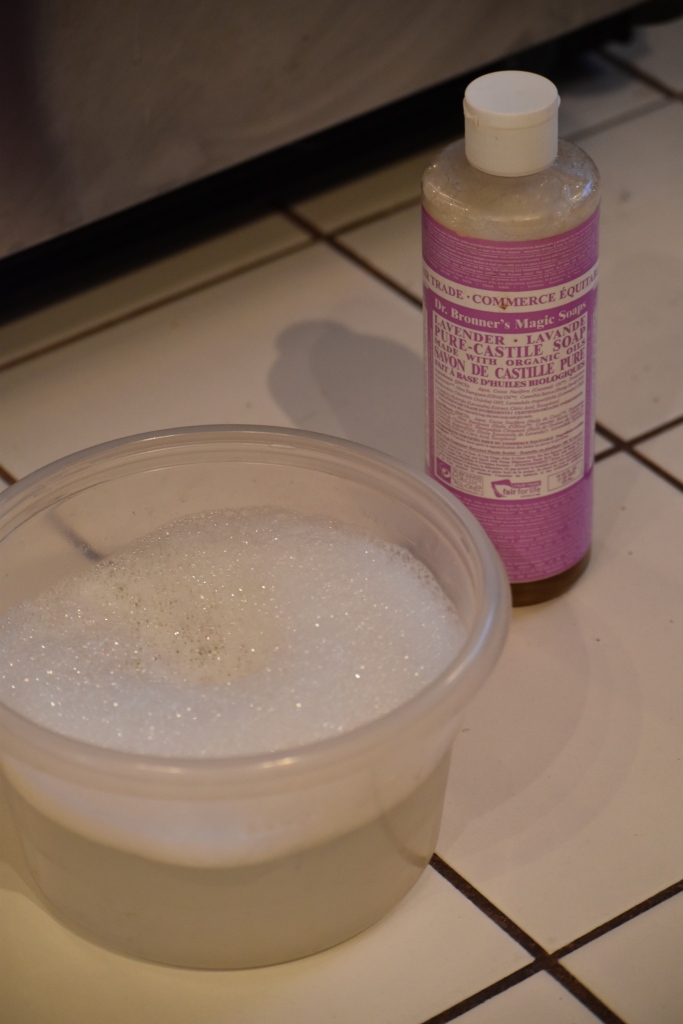Organizing my fridge is something I have struggled with for a long time. It’s not easy keeping everything tidy in a spot where numerous people are moving things around all day, every day. So that’s why I thought it would be a great idea to share with you all the best tips to clean up your fridge and stay organized.
Step 1: Empty the fridge (one shelf at a time)
For obvious reasons, it’s not the best idea to take EVERYTHING out of the fridge, so we’re going to go at it one shelf or drawer at a time. Personally, I always start from the top because there are definitely going to be crumbs and/or spills, and I would much rather wipe them down and continue cleaning in that fashion so that nothing remains at the end of my clean. I always do the door of the fridge at the very end.

Step 2: Wipe it down
After I’ve emptied out the first shelf of my fridge, I grab a small bucket, put a few drops of Castile Soap (Lavender scented is my current favourite) and fill it up with hot water. Rags or reusable cloths are your best friend when it comes to cleaning tough spots like the fridge – not to mention way more sustainable than using paper towel. And if you’re like me and you’re a little grossed out at the idea of using a cloth, grab yourself a second bucket with warm water only and rinse out your cloth after it gets dirty.
As for the drawers, if they are too dirty, I just give them a wipe down like the shelves. However, if they have accumulated some funky stuff in the bottom, it is best to take them out of the fridge, let them soak in soapy water, and then wipe them down. Our current drawers don’t fit in the sink, so I just transfer hot soapy water into them and let them soak on the counter top.

Step 3: Purge
Once all of your fridge products are on the counter (or on the floor if you don’t have enough counter space), take a good look at every time carefully. Look for expiry dates. Anything that is expired should be thrown out – if you didn’t use it up before it expired, maybe you should rethink purchasing that item, or try to find a smaller portion if you need to buy more. You should also be looking for items that may have gone bad, even if they aren’t passed the expiry date.
Step 4: Organize
The last step in this process is the actual organization part. Now that you have less stuff, it’s time to get everything in order. Depending on what kind of fridge you have, you might want to use bins to keep similar items together. It doesn’t work for everyone though, especially if you live in shared quarters like we do. In that case, we either avoid bins completely, or use them to divide the items according to who owns what. If that’s the case, it would be important to label the bins with names or initials.
Currently, we are simplifying how we organize our fridge. The bottom shelf is reserved for my brother, who lives in the house with us, with the exception of our milk bags being kept there in a bin that fits on that shelf perfectly. The middle shelf usually contains leftovers, oversized vegetables that can’t fit in the drawer, and tall bottles that don’t fit in the fridge door. We also keep our eggs here underneath a small drawer because they fit perfectly under there. As for the top shelf, that’s where things get a bit more disorganized because it’s where everything else goes. Therefor we make it a point to take extra care of the top shelf, cleaning it out weekly to make sure we don’t let anything go bad.
To help minimize waste in our fridge, we’ve come up with a new system that has been working great so far and it’s all thanks to our good fridge, the dry erase marker.

If you have a stainless steel fridge, you need to try this method to help keep your fridge clean and organized – not to mention you can tell what’s in your fridge without constantly opening, closing, and moving stuff around!
Although I did say the top shelf is the messiest spot for us, it could very well be the fridge door for some people. This tends to get cluttered real fast, and it’s almost always stuff that is for occasional use. There are condiments and sauces of all sorts that pile up, so it’s important to go through them all and make sure you either use them, or throw them out.
EXTRA TIP: Store products properly to maximize their shelf life
- Canned vegetables should be transferred to mason jars;
- Half used vegetables should be chopped up and put into containers;
- Leftovers should be transferred into containers and not kept in the casserole dish or pan;
- Jars should all be sealed tight – clean up drips and spills on all bottles;